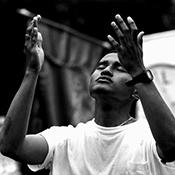From Pentecostals speaking in tongues to silent monastic contemplation, prayer is central to Christian life. Prayer can be communal or individual; it might consist of well-established texts, like the Lord’s Prayer, or spontaneous thoughts. Through varied postures, actions, and settings of prayer, Christians engage with God.
View full album
“Prayer is a conversation with God,” says African American theologian James M. Washington, author of Conversations with God, which recounts the traditions of prayer in the Black church. The human side of that conversation takes many forms. There is the offering of praise, such as the “Praise God!” commonly heard in the call-and-response forms of prayer in the Black worshiping community. And there is the language of thanksgiving, for prayer is what Washington calls “an attempt to count the stars of our souls.” The words “Thank you…Thank you…Thank you” are a way of calling to mind, one after another, the gifts of God, the stars of the soul. With the language of repentance and confession, one turns inward in honesty to humble oneself before God. And with words of petition, one lays before God the day’s most immediate needs and the soul’s profoundest longings.
Whether congregational or individual, prayer is a disposition of the heart, a way of being as much as a ritual act. It is a conversation with God that involves listening and speaking. And many who pray attest that these words of thanks, praise, repentance, and petition take place anywhere and everywhere. For Christians, prayer is not reserved for churches or for Sundays; it is an ongoing, daily attentiveness to God’s presence.
There are many postures of prayer: kneeling with eyes closed, standing with arms raised, sitting with head bowed. People also pray in a variety of settings. In a recent survey about prayer among Episcopalians, people responded that they pray when they are out running in the morning, when they swim laps at the pool, when they walk on the beach, and when they take a break at the office. One Alaska school teacher said, “I go to my room whenever I need to pray. I lock myself in and kneel down. Other times, I just look up at the sky—I’m thankful for the air we breathe, the wind, the clouds, the earth we walk on.”
Some prayers are very old and those who pray them know their words by heart. So it is with the Lord’s Prayer, the words of prayer that Jesus taught to the disciples. Many prayers come directly from scripture, especially from the Psalms. Those who use this ancient treasury make the words their own and repeat them from the heart. The Book of Common Prayer, used by the Episcopal Church, contains prayers called “Collects” for every week of the year, for every season, for every occasion. Many find the deepest meaning in the words of those prayers that they have prayed many times over. On the first Sunday in Advent, for example, the congregation in every Episcopal church will pray, “Almighty God, Give us grace that we may cast away the works of darkness and put upon us the armor of light…” The words are so well known that those who pray rest deeply in their meaning, no matter how many times they are said. In this sense, a prayer is like saying, “I love you": spoken from the heart, the words do not become worn out with repeated use. Indeed, no other words would suffice.
Some Christians, especially in the Reformed, Evangelical, and Pentecostal traditions, emphasize spontaneous prayers that arise from the heart over structured prayers that are read or memorized. These Christians often meet in groups to pray together, either in the church or in homes. In prayer groups like Aglow, people might meet in person for prayer or online as a part of the Aglow Prayer Net (APN). Individuals may also join specific prayer groups that ask for God’s guidance in politics, for peace around the world, or for other “global prayer targets” that change monthly. In Pentecostal churches, the experience of “speaking in tongues'” comes from a “baptism by the Holy Spirit” like that of the early apostles at the time of Pentecost. It is an experience in which prayer is vocalized in ecstatic utterances, often in language not intelligible even to the speaker, but deeply meaningful.
There are many who find the deepest form of prayer to be silent and wordless. In this way, prayer is cultivating the “attention of the heart.” At an Ash Wednesday retreat at Our Lady of Grace Monastery in Indiana, Benedictine sisters lead a group of women, including many Protestants, in “centering prayer,” which is a practice of silent meditation. In this practice, the repetition of a sacred word or phrase leads to deep stillness, a form of spiritual practice common in Hindu, Buddhist, and Jain traditions as well.
Contemplative prayer traditions are very old in Christianity and are preserved in the monastic life of both Orthodox and Catholic traditions. Today, however, there is a keen interest in contemplative prayer even among lay Christians. The writings of the Trappist monk Thomas Merton have been widely read for the guidance he offers to those who wish to take the inner life of prayer seriously. Merton himself was drawn not only to Catholic traditions of prayer, but to the Desert Fathers and the Orthodox “prayer of the heart,” sometimes called “the Jesus prayer.” Thomas Merton also explored Eastern spirituality, especially through his acquaintance with Buddhist monks and their traditions of meditation. In Contemplative Prayer, he writes of the value of that “interior silence in which the mystery of God’s love is made clear to us.”
